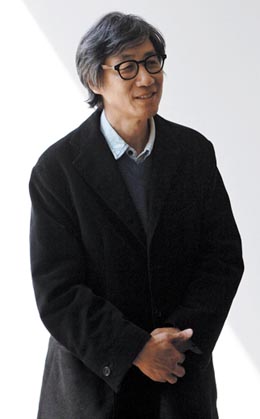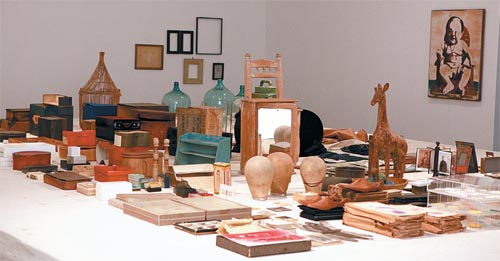A new angle on everyday objects

Koo Bohn-chang
On the first floor, various objects are scattered about in what looks like a haphazard fashion. Old foreign magazines are hung on a wall and an old-fashioned electric fan stands in a corner. On a wide table in another corner are all kinds of odds and ends, including old toys, shoes, bottles and boxes of various shapes. Empty picture frames hang on the walls around the table. Everything is from Koo’s personal collection.
“I’ve been drawn to the power of everyday objects since I was young,” the 58-year-old artist told reporters at the opening of the show late last month. “I collect everything, not just rare or exotic things but anything that attracts my attention among all of the ordinary objects I come across in life. My collection cannot really be categorized.”
Koo’s mania for collecting is deeply related to his art. His well-known photos of Joseon Dynasty (1392-1910) white porcelain and of ordinary objects such as an empty birdcage show he is interested in presenting new images of things that we are already familiar with .
“When I find a cosmetics bottle, I don’t see it as a commercial product,” he said. “I focus on the vessel and its aesthetic aspects. I observe it under one kind of light and then another.”

From top, “MGM 01” and “MGM 04” (2009) from Koo Bohn-chang’s “Mask” series and “JUN 03” (2010) from his “Vessel” series. Provided by the artist and Kukje Gallery
Koo gained fame among art connoisseurs in the early 1990s with his “In the Beginning” series, a group of black-and-white photos depicting human bodies struggling under pressure. But it was the “Vessel” series, created in the 2000s, that brought him widespread attention among the general public.
Koo showed the photos in an exhibition called “Plain Beauty” at the Philadelphia Museum of Art in the United States last summer. Hyunsoo Woo, the museum’s Maxine and Howard Lewis Associate Curator of Korean Art, said of the photos, “Koo captures the stained, cracked and worn surfaces of these ceramics in a beautiful and subtle light.”
At the press conference in Korea, Koo described how his interest in vessels had come about.
“In recent years, I’ve become especially interested in empty objects - the things that are supposed to contain something but do not now - such as empty picture frames and empty boxes,” Koo said. “I’ve come to have an interest in such things as I’ve become more aware of the charms of East Asia - the beauty of empty space in East Asian art.”
In a black box theater on the gallery’s first floor are two screens, one showing snapshots that the artist took while studying in Germany in the 1980s and another showing the photos he took upon his return to Korea around 1988.
Koo said that prior to his trip to Germany he had been longing to see something new and that once he was there he was fascinated by what he saw. At the same time, however, he said that it was there that he came to understand his identity as an Asian in the West. The snapshots reflect this inner tension.
“Koo has always focused more on investigating a more personal vocabulary and inner exploration and avoided the more factual concrete documentary style of his peers,” Kim Sung-won, the curator of the Kukje show, wrote in the English version of the exhibition catalog.

Various odds and ends from the collection of photographer Koo Bohn-chang are part of the artist’s solo exhibition at Kukje Gallery, located on the art street east of Gyeongbok Palace. Provided by the gallery
On the wall of the staircase leading up to the second floor are objects that have appeared in earlier works, including a pocket watch featured in the “Breath” series.
Visitors finally come face to face with Koo’s photographs on the second floor. They include the photos of Joseon Dynasty objects: moon jars, masks from his “Mask” series and agalmatolite stone pots from his “Gopdol” series.
These objects are not from Koo’s own collection but from others’. The moon jars are from the collection of Korean-Japanese architect Itami Jun. The masks are from the Musee Guimet in Paris. The stone pots belong to Japanese philosopher Yanagi Soetsu.
One trait the photos have in common is the minimal contrast between light and shadow.
“I take the photos in such a way that viewers can’t tell where the light and shadows are coming from,” the artist said. “In doing so, I reduce the concrete, materialistic qualities of the objects so that viewers can find something new in them, instead of just viewing them as commonplace.”
In approaching his work, he “talks with the objects,” he said.
“Imagination is also important,” he said, recounting an episode in which he saw a mountain and stream appear in a wet stone in the Japanese rock garden at his home when he was young.
When asked what advice he would offer to the increasing number of hobbyists who want to take professional-looking photos with their digital single-lens reflex cameras, he again emphasized the necessity of “conversing with the subject” and viewing them from new angles.
“I see many amateur photographers traveling in groups to take photos, but I don’t think that’s a good way,” he said. “Can you communicate with a subject in a large group? People should leave the group to take photos.”
He added, “Even when you take photos of family and friends, don’t think of them as people you know. Look at them and find something new about them. Then you can take good photos.”
Koo Bohn-chang
- Professor of photography and video at Kyungil University
- Education: Fachhochschule diploma in photography from Hamburg. Bachelor’s degree in business administration at Yonsei University
- Solo exhibitions: “Plain Beauty” at the Philadelphia Museum of Art in 2010, “Purity” at Galerie Raum mit Licht in Vienna in 2009, “Masks” and “White” at Galerie Camera Obscura in Paris in 2004 and many others.
Koo’s photos are in the collections of the Museum of Fine Arts in Houston, the San Francisco Museum of Modern Art, the National Museum of Contemporary Art Korea and many other institutions.
*The exhibition runs through April 30. Admission is free. The gallery is open Mondays to Saturdays from 10 a.m. to 6 p.m. and Sundays until 5 p.m. Go to Anguk Station, line No. 3, exit 1, and walk for about 10 minutes. For more information, visit www.kukje.org or call (02) 735-8449.
By Moon So-young [symoon@joongang.co.kr]
한글 관련 기사 [중앙일보]
구본창 사진미학의 저수지, 유년의 잡동사니를 만나다
‘컬렉션’ 주제 5년 만의 개인전
어린 시절 유난히 내성적인 소년이 있었다. 친구들과 어울리는 대신 집안 구석구석의 물건과 얘기하는 것을 즐겼다. 윙 소리를 내며 돌아가는 선풍기, 싸구려 가짜 고려청자, 김치 독을 파묻으려 마당을 파다 나온 백자 수반 등등. 형이 구독하던 영어 잡지는 그에게 새로운 세상을 보여줬다. 뉴스위크, 타임, 라이프지 등이다. 표지를 장식한 카트린느 드뇌브나 폴 매카트니, 혹은 샤갈 전시 소식에 시선이 꽂혔다. 섬유회사에 다니며 당시로서는 드물게도 해외 출장을 다녔던 아버지는 알프스 풍경 등을 담은 외국 달력, 도쿄 올림픽 팸플릿 같은 것을 보여주었다.
세계 여행가 김찬삼이 쓴 『세계일주 무전여행기』는 소년이 몇 번씩 탐독한 책이었다. 언젠가 먼 세상으로 떠나리라 꿈꿨다. 집에는 아버지가 가져온 다양한 색깔의 실이나 섬유조각이 많았다. 소년은 그 색채감에 반했다. 어머니의 다리미나 나무인형 같은 여성적 소품, 빈 상자, 유리병도 모았다. 방안은 늘 잡동사니로 가득 찼고, 이사를 다닐 때면 트렁크에 담아 끌고 갔다.
사진작가 구본창(58)씨 얘기다. 구씨가 서울 소격동 국제갤러리에서 개인전을 열고 있다. 2006년 이후 5년 만이다. 30년 작가 세계를 돌아보는 회고전 성격을 띠고 있다. 전시 키워드는 ‘컬렉션’. 구씨에게 예술적 영감을 주고, 그의 예술론을 엿볼 수 있게 하는 개인 수집품을 공개하고, 다른 사람들의 컬렉션을 찍은 신작을 함께 전시했다.
전시장 1층은 구씨만의 만물상이다. 잡지표지, LP커버에서, 나무인형, 실타래, 나비표본, 도자기, 오래된 사진 등이 진열됐다. 내용물 없는 빈 상자, 빈 유리병, 빈 액자 등도 상당수다. 여섯 살 때 시작된 수집벽과 나이 들어 세계 곳곳을 여행하며 모은 것이라지만 되레 평범하고 사소해 보인다.
“저는 비싸고 귀하거나 특별한 물건을 모으지 않아요. 명품, 진품 컬렉션과는 거리가 멀죠. 남들이 보기엔 하찮고 사소한 것에 눈길이 끌려요. 저 외에는 아무도 관심을 갖지 않고, 저를 만나지 않았더라면 쉽게 버려졌을 법한, 저만의 컬렉션이죠. 이런 수집벽은 결국 제 사진에도 영향을 미친 것 같아요. 약한 것을 연민하고, 가득 채우는 것보다 비우는 미학에 끌리게 된 거죠.”
구본창 사진미학의 원천인 셈이다. 그는 “평생 남들이 쉽게 귀 기울이지 않는 것, 모퉁이에 있는 것에 관심이 있었던 것 같다”며 “대표작인 백자 작업도 그렇게 출발했다. 텅 비어서 채워지길 기다리는 백자가 귀족적인 청자보다 더 매력적이었다”고 했다.
2층에는 5년 만에 선보이는 신작이 공개된다. 프랑스 기메 박물관의 ‘한국의 탈’ 컬렉션, 일본 도쿄 민예관이 소장한 야나기 무네요시의 ‘한국 곱돌’ 컬렉션, 오사카 동양도자박물관의 ‘한국 백자’ 컬렉션 등이다. 백자 달항아리 사진은 재일동포 건축가 이타미 준의 컬렉션이다. 기메 박물관 탈 컬렉션은 1870년대 프랑스 신부가 수집해간 것으로, 해학적인 전통 탈과 달리 귀기(鬼氣) 어린 모습이 특징적이다. 구씨는 “타인의 컬렉션을 촬영해, 내 컬렉션에 추가해 수집목록을 늘인 셈”이라며 웃었다.
80년대 독일 유학시절과 귀국 직후 찍은 미공개 사진도 선보인다. 88 올림픽 전후의 한국사회와 도시의 특징적 표정을 담은 컬러사진이다. 최근의 정적인 작업과 대비된다. 그의 작품’ 숨’의 소재가 된 회중시계, ‘굿바이 파라다이스’의 근간이 된 곤충표본 등도 함께 소개된다. 북디자이너 정병규씨는 “구본창 수집품의 특징은 이름없음과 낡음이다. 구씨의 사진은 한마디로 수집적 상상력의 세계”라고 평했다. 4월 30일까지. 02-735-8449.










with the Korea JoongAng Daily
To write comments, please log in to one of the accounts.
Standards Board Policy (0/250자)